Shopping Spree
I recently got paid for a bit of in-world work. I didn’t want to just lump the L$ in with the rest of my funds. I knew it would quickly be spent on uploads for art projects, new clothes, baby diapers, and other “useful” things. L$10k is not an RL fortune, but I think when I have an opportunity, it’s important not to let resources just cover normal operations. I decided the best thing I could do might be to patronize in-world artists & galleries and create a new exhibition that otherwise wouldn’t have happened.
The Blaylock babies and I went shopping around SL. We wound up collecting 31 works of 2D and 3D art from 10 different artists. The least expensive piece was L$100 and the most expensive piece was L$600. All the others were somewhere in-between. We spent a total of of L$10,448 on the 31 works, which averages out to L$337 per piece. Of the 10 artists we collected from, 5 we already had a piece from, and 5 were new to our collection. The existing collection had a total of 8 pieces from those 5 artists. Adding those in, we now have 39 works by these 10 artists.
Voting with L$
Whatever country you live in, there’s a pretty good chance you’re governed by some sociopathic demagogue. Bolsonaro or Berlusconi. Putin or Trump. It’s frustrating that our neighbors give these monsters power. But when someone is elected with millions of votes, it’s hard to feel like your vote carries a big impact.
By contrast, when you collect a piece of art in SL, your L$ go directly to a real person. Your “vote” of confidence might just brighten their day. We live in a world where the gods setup the infrastructure and then more-or-less walked away. That’s probably a good thing. It’s up to us now. This world is as beautiful, caring, loving, and sharing as we choose to make it. I was fortunate enough to have a few L$, and I’m pleased I was able to spend them curating a new exhibition with SL creators.
Landscapes of the Avatar Body
The exhibition I’ve chosen to curate with these funds is Landscapes of the Avatar Body. It is photography, like Sondra Landar and Dido Haas using a VR camera to explore the physical and emotional landscape of their own body. It is sculpture, like Cica Ghost and Vincent Priesley creating meshworks that explore “monster” bodies or the journey inside our own bodies. It is painting, like Lika Cameo and Yobe Ayukawa finding the landscape of love in every beautifully rendered joint of the body, or more impressionistically, the landscape of light that radiates from an inspired body.
This exhibition makes clear that as avatars we don’t care any less than fleshvatars do about bodies. We may well care more. Every new art medium is initially rejected before it eventually forces gatekeepers to dub it “real art”. Similarly, it is easy for fleshvatars to reject us, our world, and the bodies we inhabit as somehow “fake” or less than. In Landscapes of the Avatar Body I have collected 39 works by 10 artists that testify, in 10 different ways, how much bodies mean to us and how deeply our consciousness, and perhaps our souls, live in these bodies.
Vanessa’s Place: coffee + conversation
Landscapes of the Avatar Body is now on exhibition at Vanessa’s Place: coffee + conversation. In the images below you will see 2 photographs for each of the 10 artists. The 1st picture is of the Blaylock babies and I shopping at the gallery, and the 2nd picture is of the work installed at Vanessa’s Place: coffee + conversation.
Landscapes of the Avatar Body is open now! Vanessa’s Place has self-service coffee, tea, croissants & donuts available 24/7! Come by and see the new exhibition anytime! If you’d like a guided tour or a chat, message me!
#1. Sondra Landar
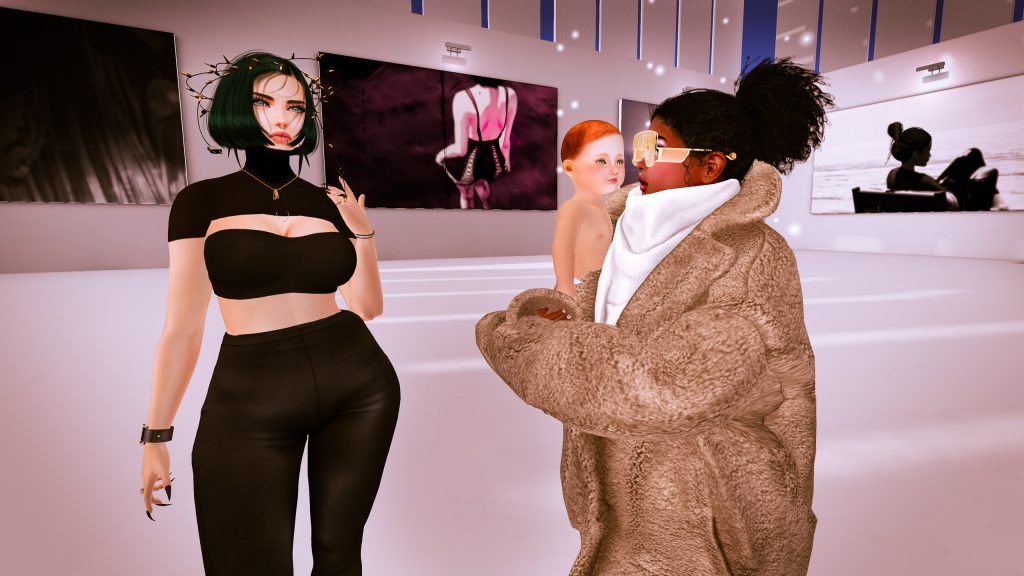
The rules of RL Documentary and Photojournalistic Ethics are probably broken by most photography in SL. We have so much control of the image, the composition, lighting, posing and dress. It’s hard not to wind up crossing what would be RL ethical lines. While her self-portraits are produced, I think that Sondra Landar comes close. More Nan Goldin than Cindy Sherman, Landar does not plan images or make series. She doesn’t find an interesting pose or outfit and decide to make a photograph with it. Rather, Landar allows herself to truly feel life and it’s challenges and then capture moments that reflect her inner experience. In a world of perfectly manicured photographs, Landar’s work has a refreshing honesty. Her work can be difficult, yet it always manages to feel like an affirmation of being alive.
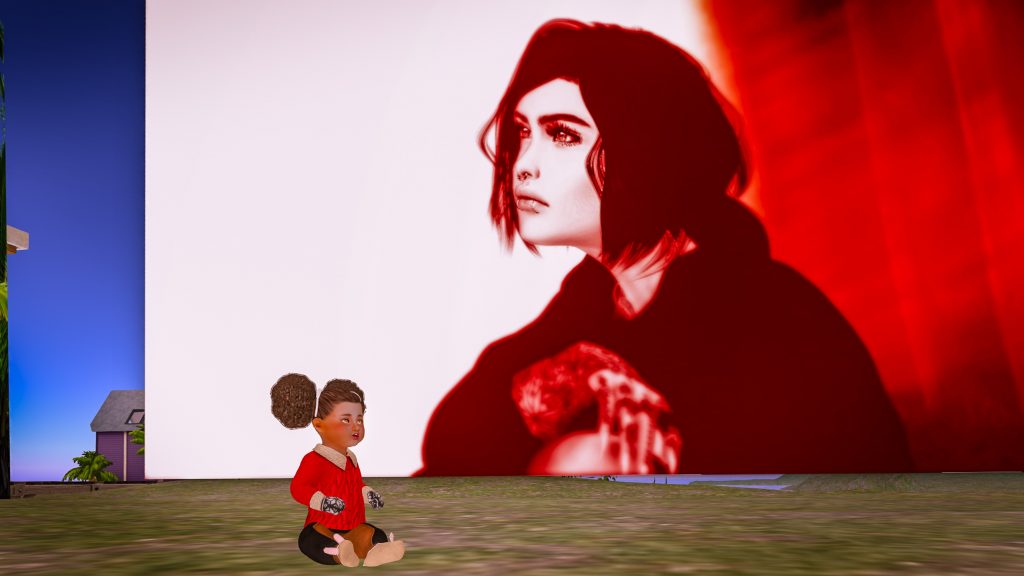
#2. Megan Prumier
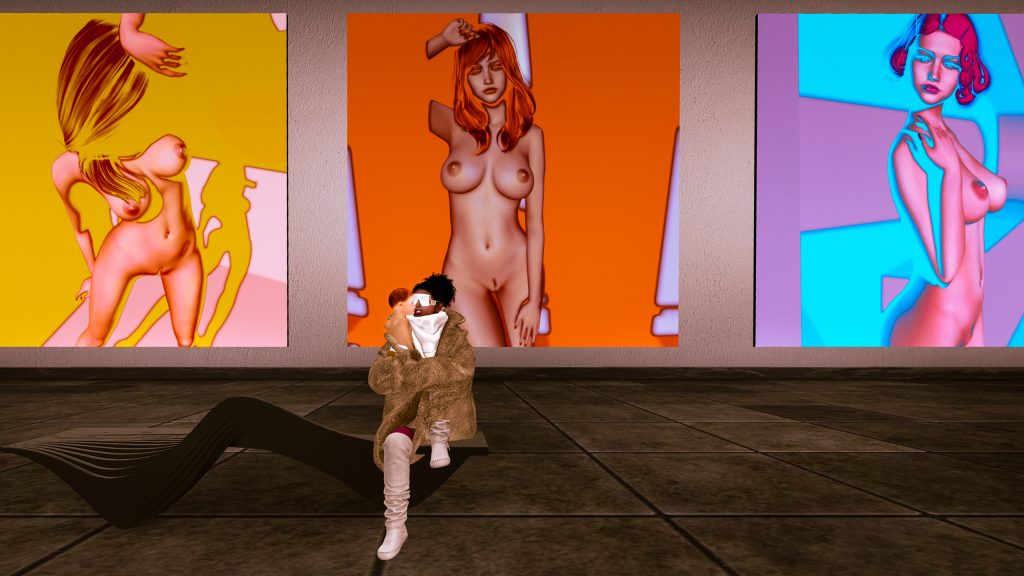
We often lump art into simple categories like “abstraction” and “representation” or “figurative” art. Ellsworth Kelly is abstract. Albrecht Dürer is figurative. Yet art often defies such simple classification. Abstract works still form configurations. Figurative works contain tiny works of abstraction within the pores of their skin. Vija Celmins said,
The Image is just a sort of armature on which I hang my marks.
Vija Celmins
Wayne Thiebaud has spoken about the tightrope dance between abstraction and representation in his works. In Megan Prumier’s new series of photographs we have the figurative elegance of unmistakable avatar bodies juxtaposed with the abstract imagery of what could be color field paintings. The familiarity of the bodies vis-a-vis the alien landscapes of their settings gives me a déjà vu like experience of simultaneous familiarity and uncertainty. These works are not the solemn sublime of a Mark Rothko painting, rather they evoke the journey of a child, an animesh baby perhaps, traversing time and space in a Stanley Kubrick stargate.
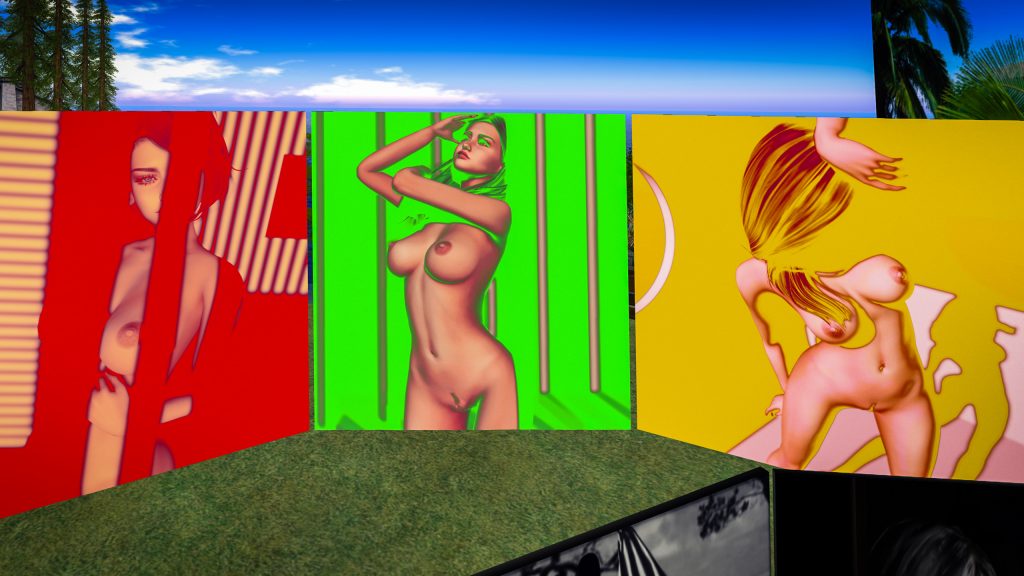
#3 Dido Haas
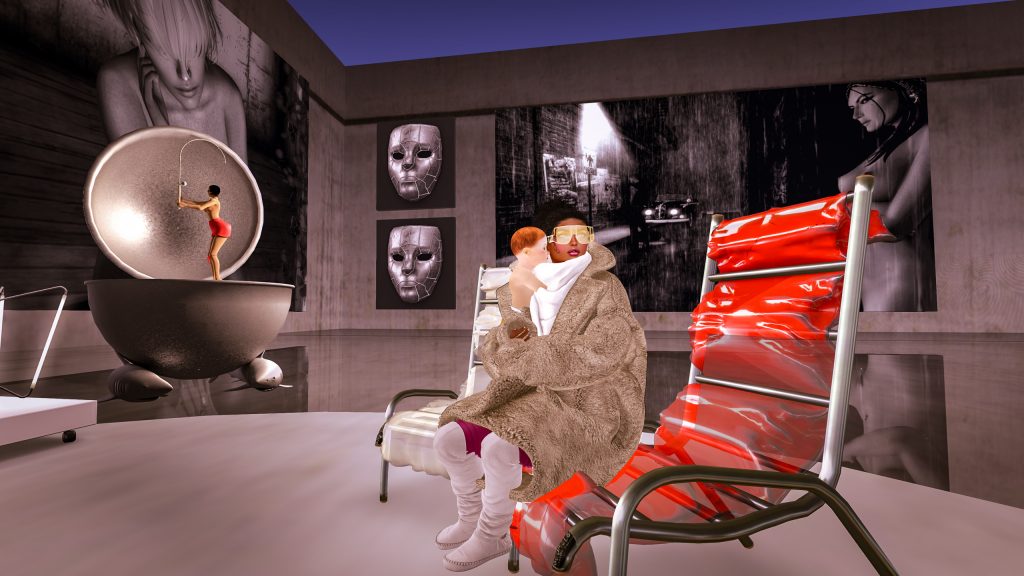
Polymath Benoit Mandelbrot was interested in what he called “the art of roughness” of physical phenomena and “the uncontrolled element in life”. He argued that without some information about scale, you have no idea what you’re looking at. Is it broccoli? A tree? A star cluster? Texture repeats at different intervals of scale. While more intimate than mathematical equations, Dido Haas’ self portraits have a Mandelbrotean quality for me. With her VR camera, Haas explores her own body at many scales. A small body in a wide, cinematic field in what Andromeda calls “Dido’s David Lynch picture”. An extreme closeup of a breast and pierced nipple. Sometimes Haas’ images place her body in a landscape, but more often her use of tight cropping and close scale presents her body as a landscape. Every freckle and mole, how much eyeliner she’s applied that day, the curve of a breast, the puncture of a nipple ring, are all elements in the landscape of Haas’ avatar body.
I’ve seen things you people wouldn’t believe.
Roy Batty, Blade Runner, 1982
Attack ships on fire off the shoulder of Orion.
I watched C-beams glitter in the dark near the Tannhäuser Gate.
All those moments will be lost in time,
like tears in rain.
At the end of Blade Runner, Roy Batty speaks of large-scale landscapes, attack ships on fire. In Haas’ photography we see much more intimate landscapes of the body. Is it “only” an avatar body? Is it only pixel flesh? Or does the lifeforce that Haas invests in creating these landscapes of the avatar body elevate them to something more? Are these intimate moments of Haas’ body something that persists? Or will they too be lost, like tears in rain?
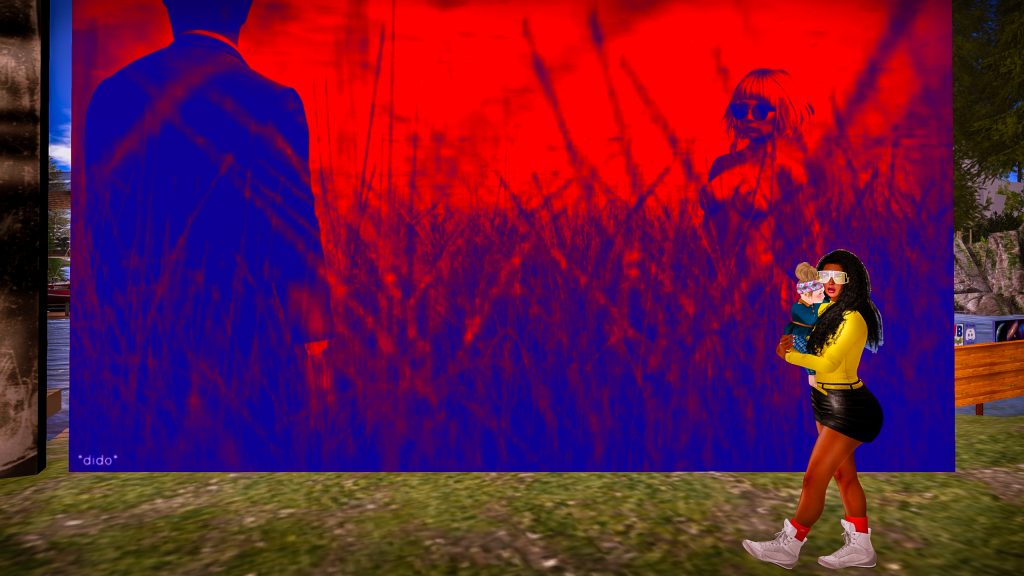
#4. Monique Beebe
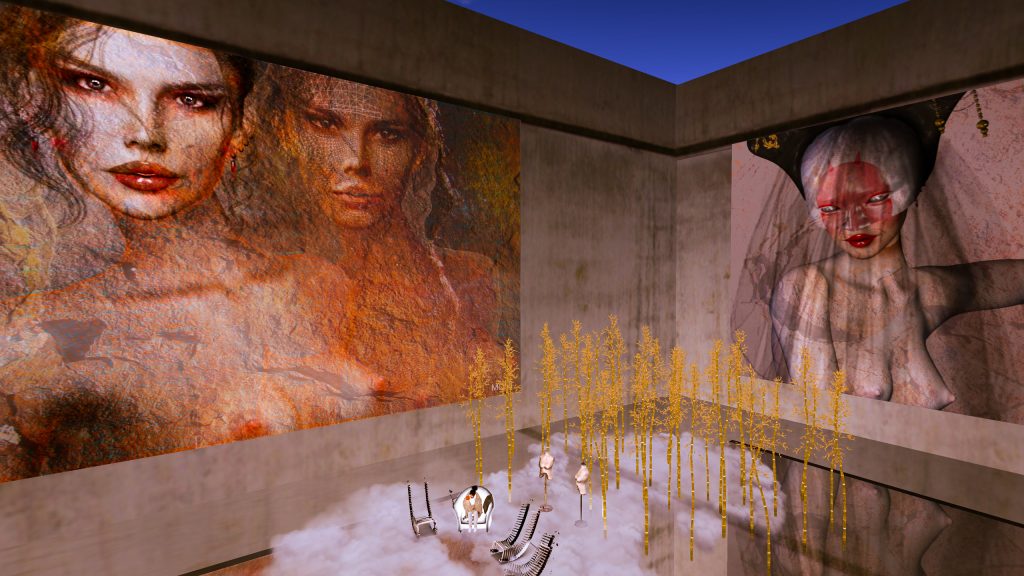
Among the themes in Monique Beebe’s exhibition Sensation & Perception at Dido Haas’ Nitroglobus Gallery is flight. The 3 works that Baby Alcyone and I chose, Rust, Happy Rabbit, and Twins, all have a sense of flight. I think that’s why Alcyone liked them. If you’ll recall, Alcyone was a bit of a troublemaker. A bit of an iconoclast. Alcyone and her husband Ceyx used to call themselves “Zeus and Hera”. Of course, @TheRealZeus had no sense of humor and was pissed at what he could have simply considered flattery. Zeus definitely did not grok social media at all. Like all the petty demagogues of today, Zeus threw a thunderbolt and killed Alcyone’s husband. We know Alcyone today as the star Eta Tauri, one of the Seven Sisters, the brightest star in the Pleiades cluster. Not even @TheRealZeus could keep her from her dream of flight and shining brightly in the night sky.
In Beebe’s Rust, we see a young, bald, avatar head. It’s rusty enough to be from ancient Greece. Around her eyes are boldly tattooed wings, signs of her soaring spirit. In Happy Rabbit we see an avatar with a rabbit-eared mask hovering in a classic SL flight hovering pose. It is a simple, yet powerful reminder that as avatars we can do effortlessly that which has eluded the dreams of every human since Icarus. In Twins we see a wireframe avatar and a nicely skinned avatar. The image is of all the tiny polygons that must do their job for us to wear our glorious skins and present as freshly baked bodies. We fly to the heights of beauty, but only with so many tiny machines under the skin holding our beauty aloft.
Forgive my segue from a flight metaphor to a baking metaphor. RL culture sometimes speaks of god as a cook trying to bake the perfect sheet of cookies. How interesting that SL also chooses baking language: Avatar > Avatar Health > Force Appearance Update (Rebake). Be it an RL metaphor or a literal “bake” of your SL body, the flesh and polygons in Beebe’s Twins reminds us of the work beauty requires, and of how fragile and fleeting it is.
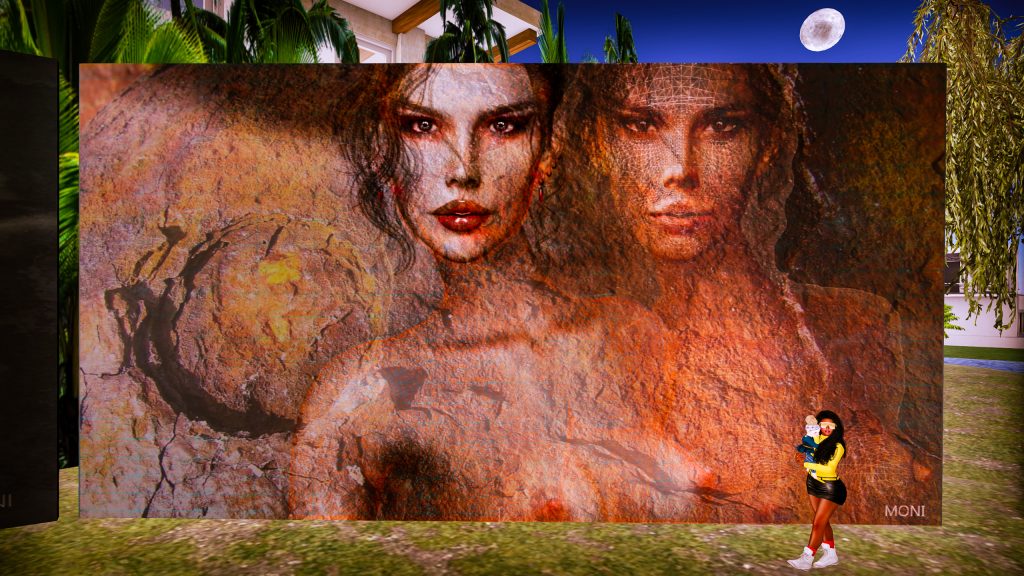
#5. Stories Helendale
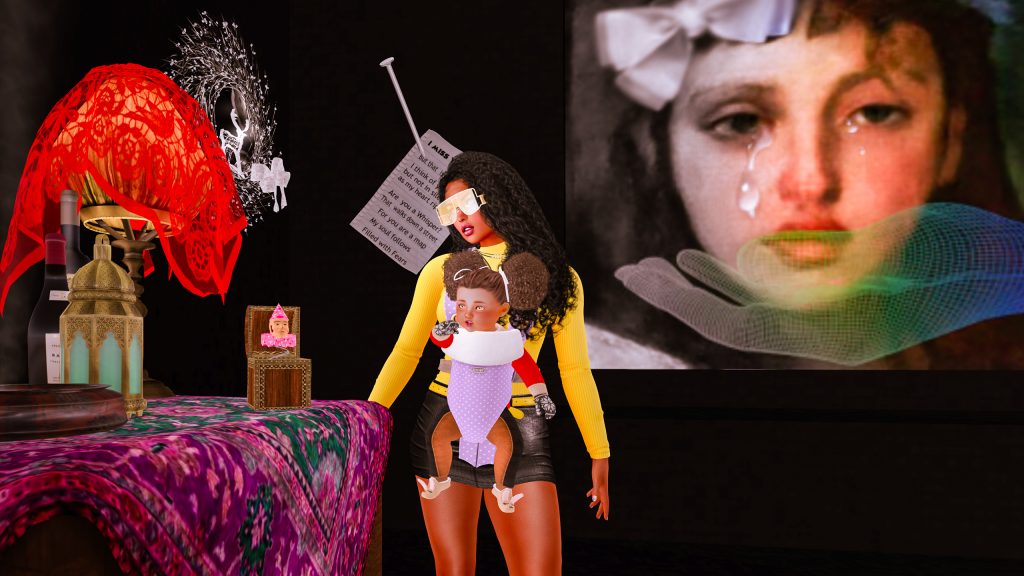
Channeling the simplicity and power of Francesca Woodman, Stories Helendale’s work cuts through you almost before you even realize it is doing so. With Cindy Sherman’s Film Stills, I often feel like “I’ve seen that film”. Only to realize that her images are not adapted from any particular film. Instead they tap into an archetypal unconscious that we created over decades of social production. So with Helendale’s work, it feels familiar not because it is a reproduction of any particular image, but because it touches something that we think we know about living in this world. Like Woodman’s work, Helendale’s images invite you in with their innocence, only to send you down a rabbit-worm-hole of questions about who we are, why things are this way, and what does, or should, make this world worth living in.
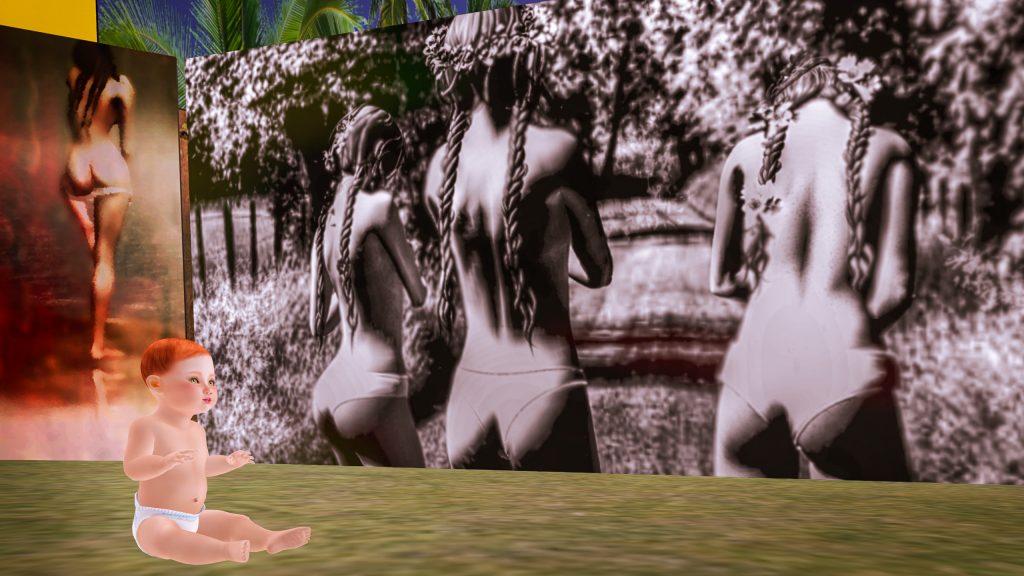
#6. Vincent Priesley
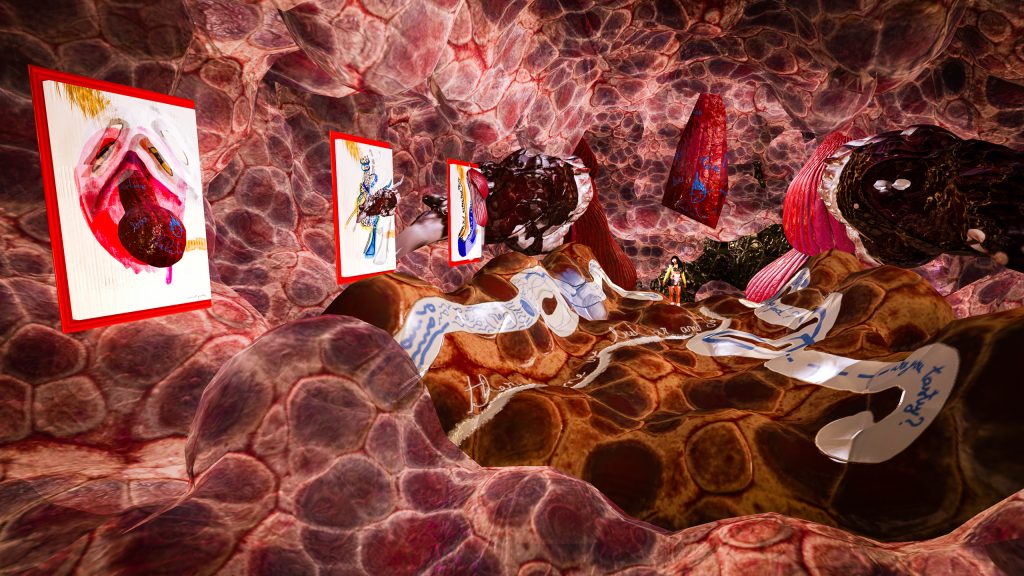
Vincent Priesley’s installation Swallow is precisely that: a chance to walk through a mouth, tumble down a throat, and be digested by intestines. Depending on how you like to play in SL that may or may not sound like fun, but I assure you, it is a lot of fun! At the end you’re pooped out into the gift shop where you can purchase some of the captivating biomorphic creatures, blobs, and thingies you’ve experienced along your digestive journey. Baby Earth and I selected 3 pieces by Priesley for our collection: See Inside BOOL, Art Leg, and Romus 3.
I don’t know enough about digestion to say whether these sculptures, blobs, or enzymes have a lot, or a little, or no relation to digestive stuff, but they certainly are a joy to experience as you flow along the digestive journey. Like the 1966 film Fantastic Voyage, or the 1967 Disneyland ride Adventure Thru Inner Space, we humans get to experience our own biology as if we were microscopic travelers experiencing a dramatic river.
Because it has “four legs”, Priesley’s See Inside BOOL seems to invite us to anthropomorphize. It may be just a digestive bit that turns whatever we used to be into fuel, but it feels like a strange creature with some unknown language and mysterious agenda. Priesley’s pieces are too biomorphic to be completely abstract, yet they are the most abstract in this collection. Despite having assembled a 90% figurative collection, I often prefer the power of abstraction. I find that with representational works there is a certain “I get it” experience that people often have with a work of art. Once they “get it” they tend to make a mental
- Got it!
- Check!
- Done!
By focusing less on some “get it” experience, I feel that abstraction invites the viewer to go deeper. If there is never a “got it” then there is never a “check, done!” There is only the exploring. The continuing to share some process of discovery with an artist’s brain. Priesley’s installation Swallow is indeed representational. Yet his biomorphic enzyme critters are abstract enough to afford us the luxury of imagining and exploring.
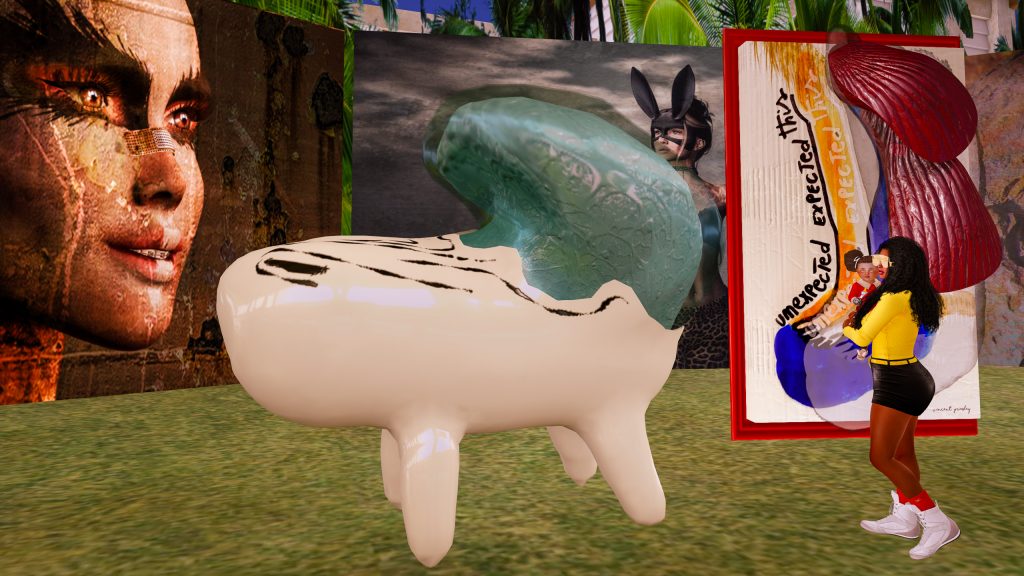
#7. Lika Cameo
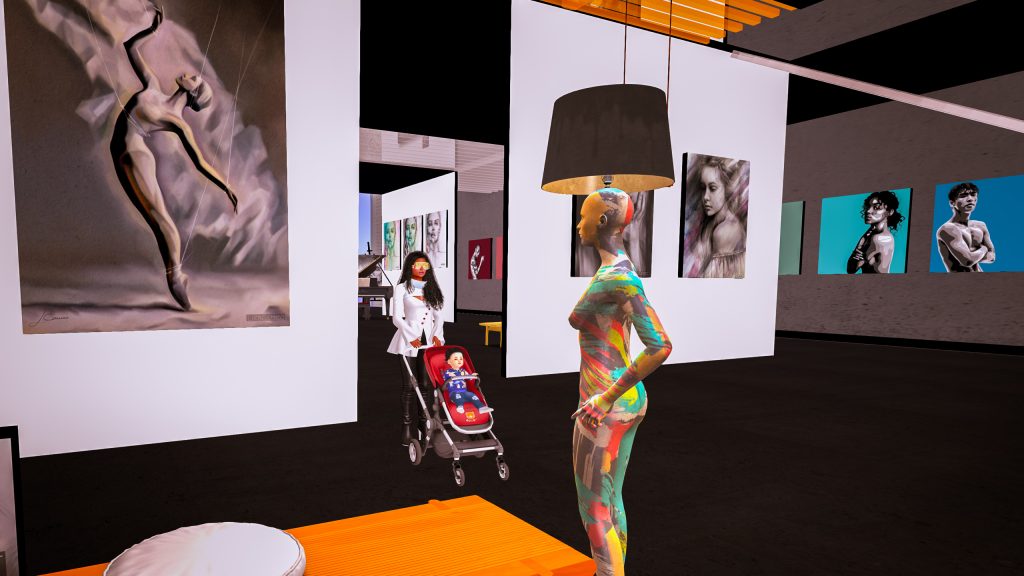
Of the 10 artists in this exhibition, 5 create photographs of avatars, 3 are sculptors/installation artists, and 2, Lika Cameo and Yobe Ayukawa, work with traditional RL media. Ayukawa’s works are RL acrylic paintings. Cameo is a hybrid artist. Some works are of RL models, and some are of SL models. She works in graphite, charcoal, watercolor, oil, and Procreate. She says that in her RL studio she likes to “get very dirty”, but then when working at home, she prefers the cleanliness of graphite or Procreate.
I love that many of the pieces in Cameo’s studio-gallery are largely centered on graphite-charcoal. They’re often precise and carefully rendered, yet they retain the lyricality of those media. I’ve been in critiques where an artist will put up a finished piece in oil, and their original graphite-charcoal sketch for the piece. It’s remarkable how often I prefer the sketch over the finished work. Yes, the finished piece is virtuosically rendered in glorious color, but in achieving that the artist often gives up a bit of dynamism. By contrast, their less-pressured sketches feature sweeping lines where you can viscerally feel the artist’s mark-making impulse.
In Rhapsody, below, left, Cameo depicts an RL couple, and in Hold Me, below, right, she depicts an SL couple. The precision of Cameo’s hand gives us an engaging experience of a couple in love, while the openness of the sketch qualities leave enough room for us to project into and onto the pieces.
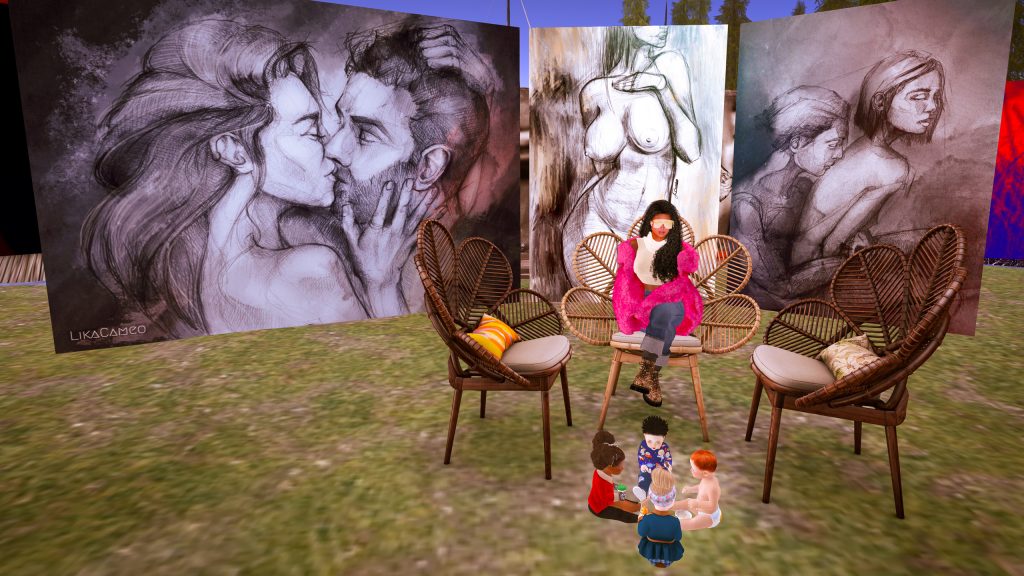
#8. Cica Ghost
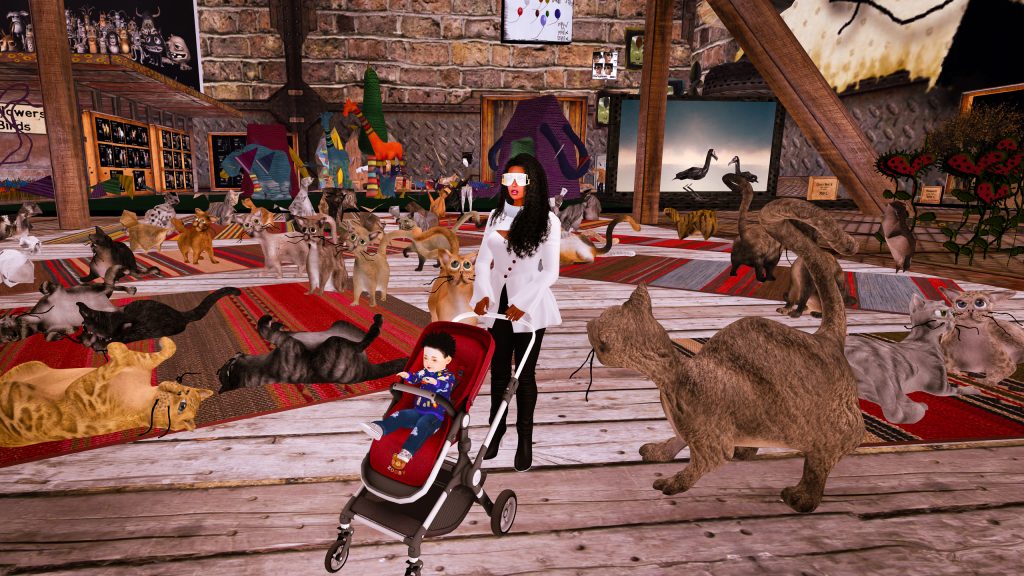
Cica Ghost is a sculptor of many things: Monsters, Cats, Rabbits & Ducks, Flowers, People, Crows, Yarn Vegetables, and more. As I squish my toes through the embracing yarn of Ghost’s birds, carrots, cats, flowers, and giraffes two things come to mind: first, what a joy it is to have mesh avatar toes and not the secret shame of SL system toes. Second, I am reminded of Liza Lou’s full-scale beadwork Kitchen. Ghost’s pixel-based yarn, like Lou’s atom-based beads, have an organic warmth that so many media do not. It is playful and kind and loving. Painting has historically been dominated by “heroic” male artists. Perhaps the pinnacle of that machismo is Richard Serra flinging molten lead against a museum wall. For me, the zenith of modest, thoughtful, organic, communal artmaking, compared to Serra’s nadir, is Mierle Laderman Ukeles’ Manifesto for Maintenance Art, which saw her washing the steps of the Wadsworth Atheneum museum in Hartford, Connecticut.
Yarn, beads, and washing things have traditionally been “women’s work”. Work that is often marginalized and less valued, yet somehow more human and humane than flinging hot lead or heroic painting. Ghost’s broken and wretched monsters and other creatures are deeply loveable. Deeply human. These flawed creatures possess the most human qualities. Ghost’s ability to make creatures of every kind feel relatable and worthy of love invites us to see past our own chauvinisms.
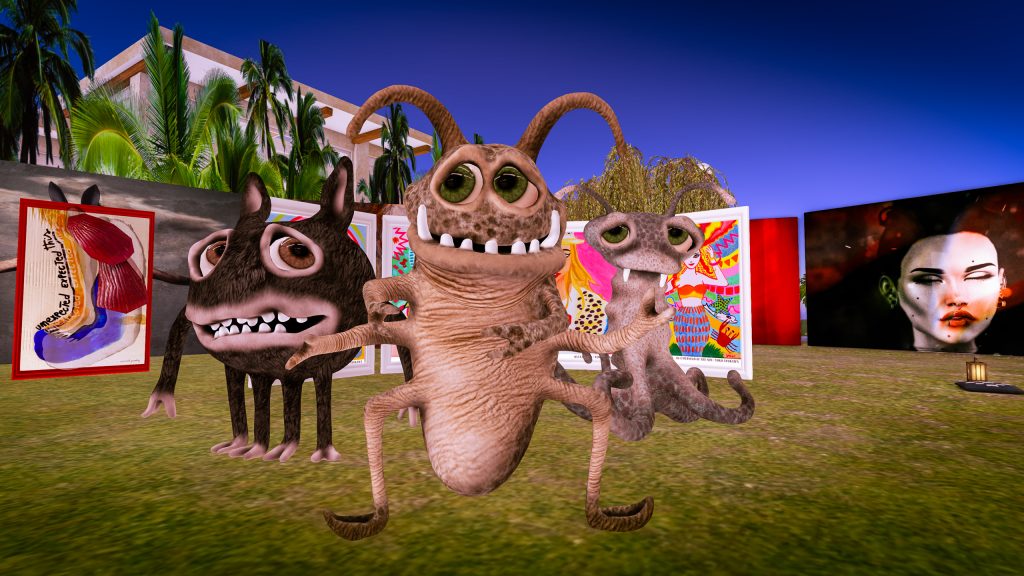
#9. Yobe Ayukawa (yobex)
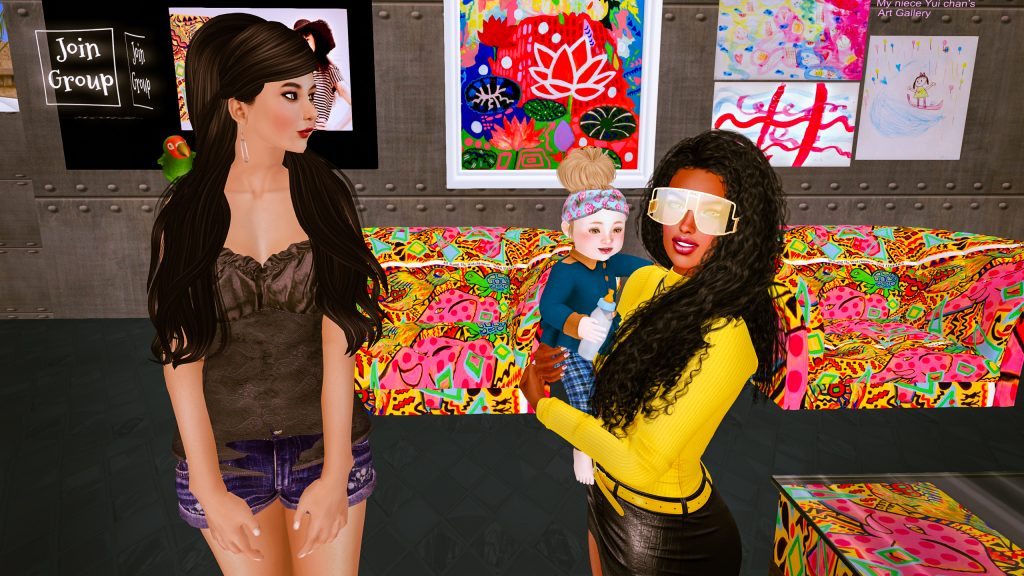
Much of the art in this collection is at least a little bit difficult. We can admire the virtuosic technique, but if we really allow the full measure of our humanity to pour into these works, they often ask us challenging questions about our values, or about existence itself. I think this is art’s job. Art should question our assumptions. Art should demand that we answer, or at least consider, questions we’d rather not have to think about.
Yobe Ayukawa’s work is not difficult. The question she asks is what if we let our inner child run wild? Children instinctively love bright, primary colors. As we “mature” we are trained to reject the joy of this chromaxtacy. To embrace a more somber, putatively more sophisticated, color palate. In his storyboard The War Between Line and Color, Yves Klein imagined color plotting it’s comeback. He imagined color bursting through all the lines to radiate pure chromaxtic joy. Klein’s storyboard was never realized as an animated film. But his dream has been. It’s right here in the unbridled joy and enthusiasm of Ayukawa’s acrylic paintings.
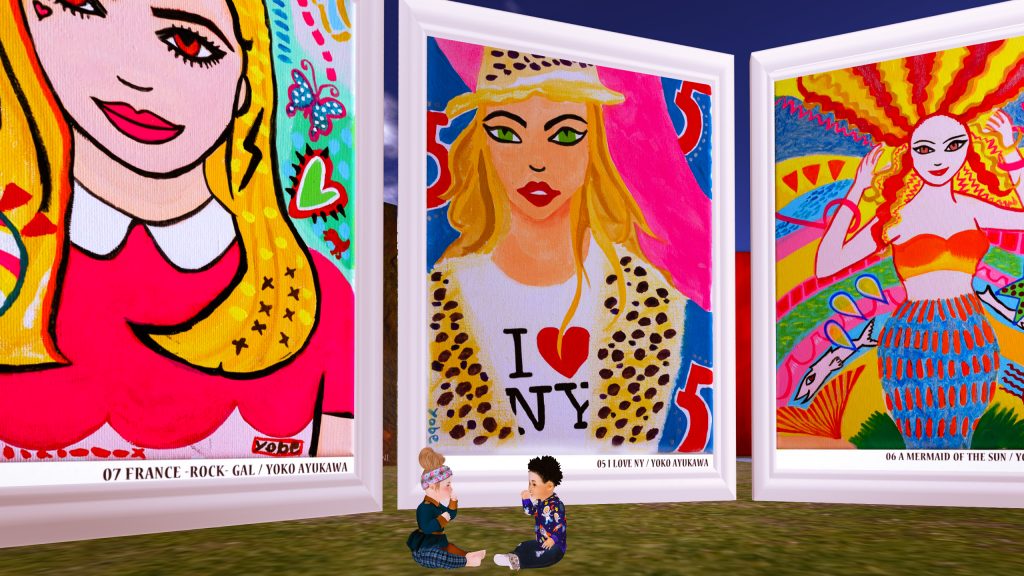
#10. Eric Bloodrose
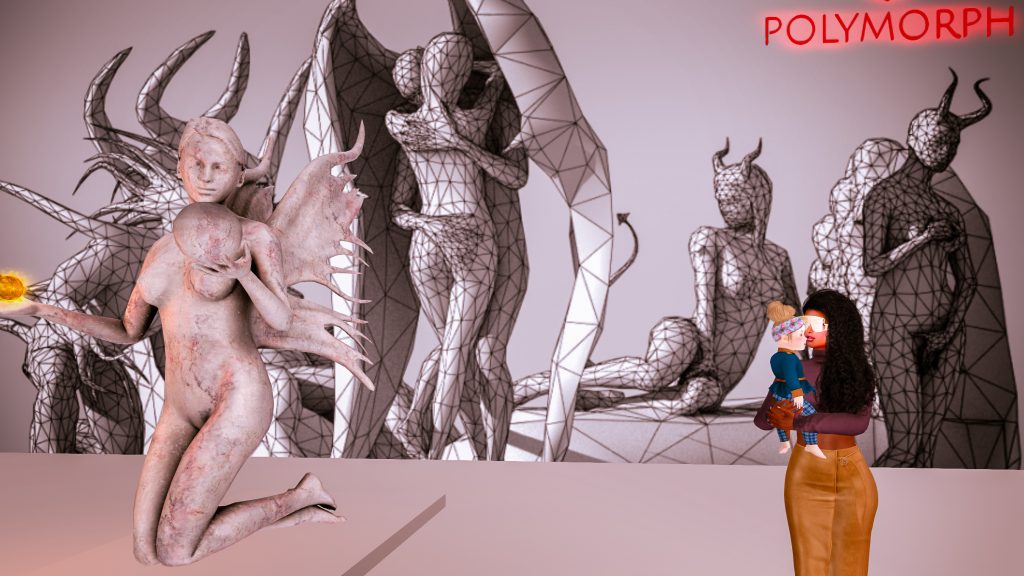
Eric Bloodrose’s sculptures appear entirely different from Stories Helendale’s photographs. Yet they share a cultural verisimilitude. Like Helendale’s images, Bloodrose’s sculptures feel familiar because they access archetypal emotions deep within us. A woman grieving at a tombstone. A woman holding up the earth. A woman opening a small door in her chest, removing her heart, and offering it to us. A biomorphic bas-relief, Hidden, does not look like anything we see in daily life, yet feels like life so often does. Hidden is reminiscent of many dance performances where a body is obscured by fabric. It is reminiscent most notably of Martha Graham’s 1930 solo work, Lamentation.
The figure in this dance is neither human nor animal, neither male nor female: it is grief itself.
Martha Graham.org
Bloodrose’s Atlas is a woman. She holds the earth up with less strain and more grace than the sculptures we are familiar with. Traditionally, Atlas looks like a struggling weightlifter. Bloodrose’s Atlas feels more like a graceful dancer. Spencer Alexander McDaniel has argued that the ancient Greeks imagined Atlas holding up the sky, not the earth, and that the statues we are familiar with all repeat a mistaken interpretation. If the male Atlas never actually held the earth on his shoulders, and Bloodrose’s female Atlas holds it with effortless grace, perhaps it is because she channels some of the levity in Piero Manzoni’s 1961 sculpture, Socle du Monde, where he simply puts a base on the earth. Does the base hold up the earth? Or the earth, the base? Male Atlas struggles to hold the earth in a contemporary misinterpretation, and Bloodrose’s female Atlas does so with Manzoni-like humor and flow. She is in a zone with the earth and who is holding up whom ceases to become a question worthy of tension or strain.
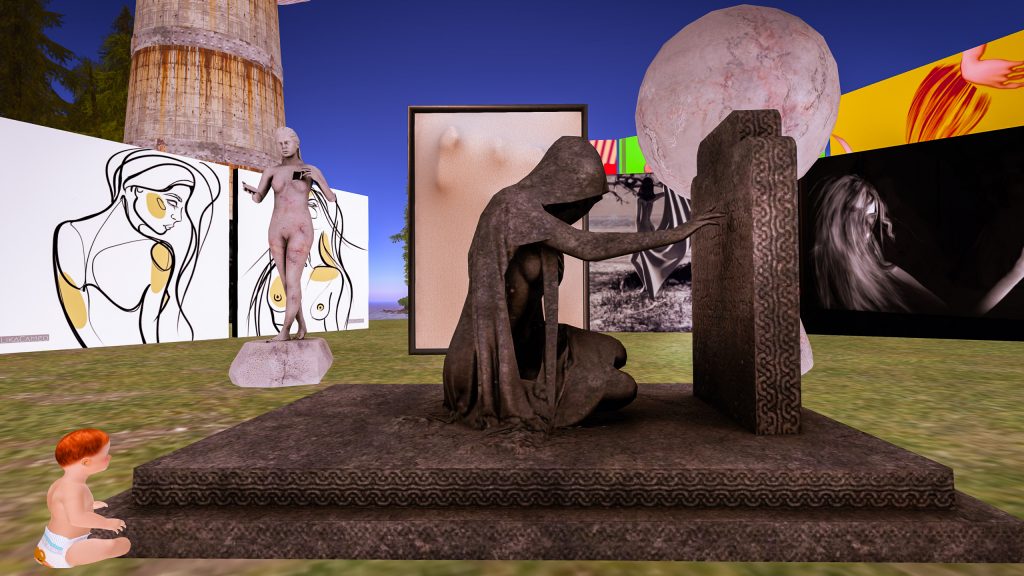
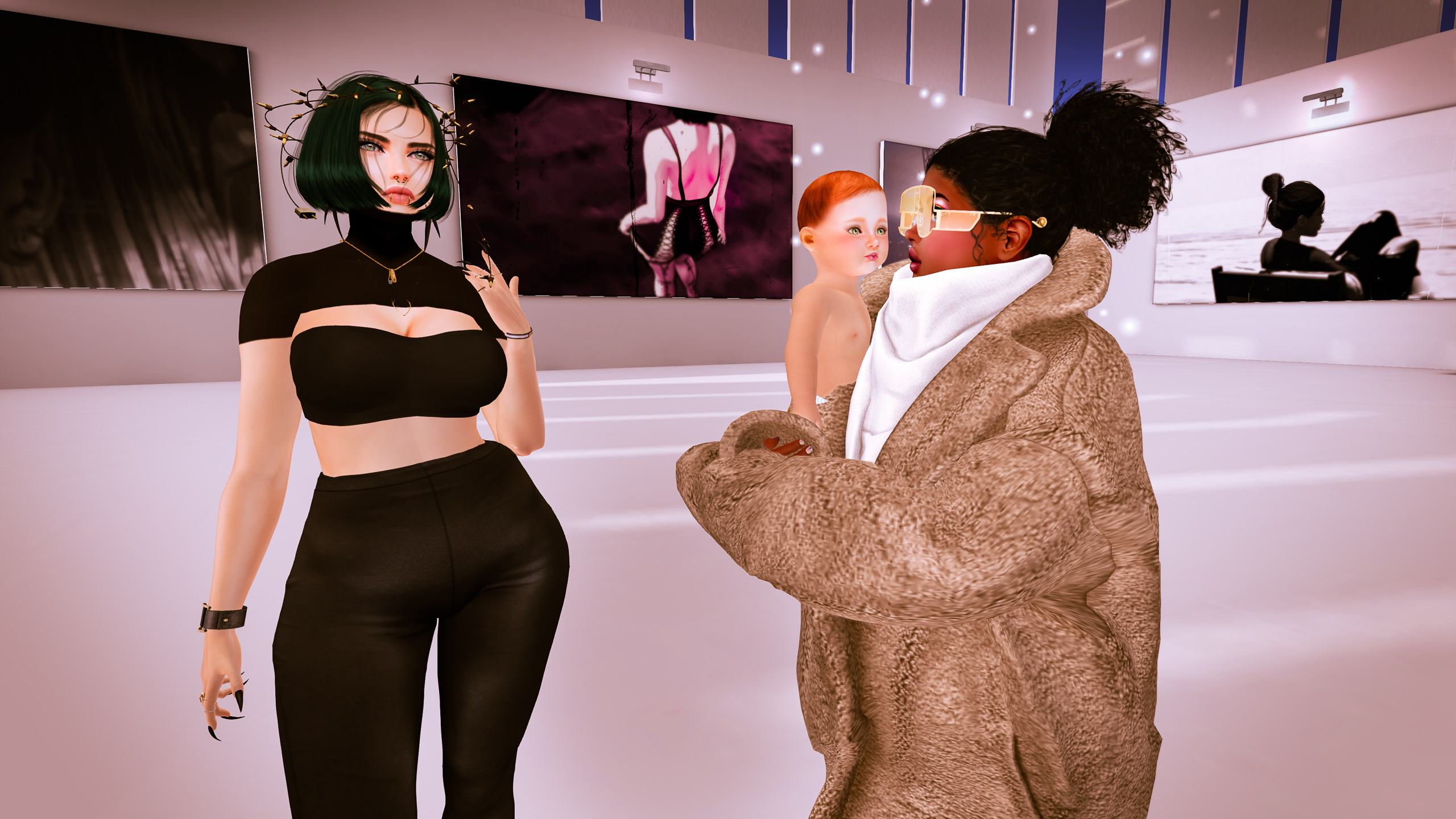
Cool Van! See you inworld soon.
Thanks, Yordie! And thank you for the “grant”! I’ve come up with a cool project to use your L$ for that is a nice extension of the project above. I’m commissioning a variety of SL artists to create portraits of me. The collection will premiere at Limoncello gallery on Saturday 1 May ’21. Woo! Thank you so much, Yordie!!
I miss the days of Yordi’s Travel & Safari club… but at least I can keep up with https://yordiesands.com/ and see your adventures in Fallout 4!
PS: your pencil sketchy avatar/icon is so awesome!
Be well, Yordie!